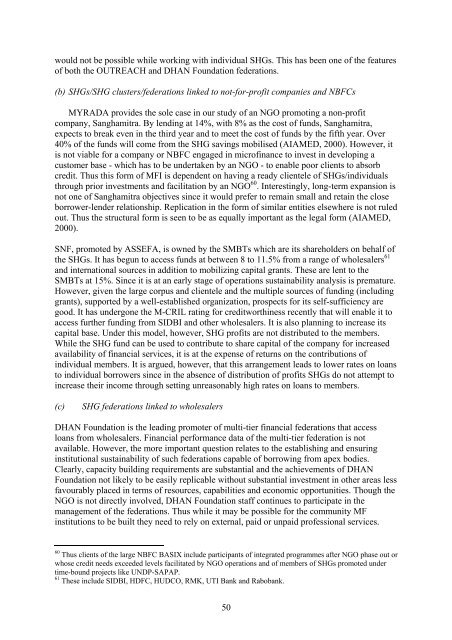Self-help Groups as Financial Intermediaries in India ... - Sa-Dhan
Self-help Groups as Financial Intermediaries in India ... - Sa-Dhan
Self-help Groups as Financial Intermediaries in India ... - Sa-Dhan
Create successful ePaper yourself
Turn your PDF publications into a flip-book with our unique Google optimized e-Paper software.
would not be possible while work<strong>in</strong>g with <strong>in</strong>dividual SHGs. This h<strong>as</strong> been one of the featuresof both the OUTREACH and DHAN Foundation federations.(b) SHGs/SHG clusters/federations l<strong>in</strong>ked to not-for-profit companies and NBFCsMYRADA provides the sole c<strong>as</strong>e <strong>in</strong> our study of an NGO promot<strong>in</strong>g a non-profitcompany, <strong>Sa</strong>nghamitra. By lend<strong>in</strong>g at 14%, with 8% <strong>as</strong> the cost of funds, <strong>Sa</strong>nghamitra,expects to break even <strong>in</strong> the third year and to meet the cost of funds by the fifth year. Over40% of the funds will come from the SHG sav<strong>in</strong>gs mobilised (AIAMED, 2000). However, itis not viable for a company or NBFC engaged <strong>in</strong> microf<strong>in</strong>ance to <strong>in</strong>vest <strong>in</strong> develop<strong>in</strong>g acustomer b<strong>as</strong>e - which h<strong>as</strong> to be undertaken by an NGO - to enable poor clients to absorbcredit. Thus this form of MFI is dependent on hav<strong>in</strong>g a ready clientele of SHGs/<strong>in</strong>dividualsthrough prior <strong>in</strong>vestments and facilitation by an NGO 60 . Interest<strong>in</strong>gly, long-term expansion isnot one of <strong>Sa</strong>nghamitra objectives s<strong>in</strong>ce it would prefer to rema<strong>in</strong> small and reta<strong>in</strong> the closeborrower-lender relationship. Replication <strong>in</strong> the form of similar entities elsewhere is not ruledout. Thus the structural form is seen to be <strong>as</strong> equally important <strong>as</strong> the legal form (AIAMED,2000).SNF, promoted by ASSEFA, is owned by the SMBTs which are its shareholders on behalf ofthe SHGs. It h<strong>as</strong> begun to access funds at between 8 to 11.5% from a range of wholesalers 61and <strong>in</strong>ternational sources <strong>in</strong> addition to mobiliz<strong>in</strong>g capital grants. These are lent to theSMBTs at 15%. S<strong>in</strong>ce it is at an early stage of operations susta<strong>in</strong>ability analysis is premature.However, given the large corpus and clientele and the multiple sources of fund<strong>in</strong>g (<strong>in</strong>clud<strong>in</strong>ggrants), supported by a well-established organization, prospects for its self-sufficiency aregood. It h<strong>as</strong> undergone the M-CRIL rat<strong>in</strong>g for creditworth<strong>in</strong>ess recently that will enable it toaccess further fund<strong>in</strong>g from SIDBI and other wholesalers. It is also plann<strong>in</strong>g to <strong>in</strong>cre<strong>as</strong>e itscapital b<strong>as</strong>e. Under this model, however, SHG profits are not distributed to the members.While the SHG fund can be used to contribute to share capital of the company for <strong>in</strong>cre<strong>as</strong>edavailability of f<strong>in</strong>ancial services, it is at the expense of returns on the contributions of<strong>in</strong>dividual members. It is argued, however, that this arrangement leads to lower rates on loansto <strong>in</strong>dividual borrowers s<strong>in</strong>ce <strong>in</strong> the absence of distribution of profits SHGs do not attempt to<strong>in</strong>cre<strong>as</strong>e their <strong>in</strong>come through sett<strong>in</strong>g unre<strong>as</strong>onably high rates on loans to members.(c)SHG federations l<strong>in</strong>ked to wholesalersDHAN Foundation is the lead<strong>in</strong>g promoter of multi-tier f<strong>in</strong>ancial federations that accessloans from wholesalers. <strong>F<strong>in</strong>ancial</strong> performance data of the multi-tier federation is notavailable. However, the more important question relates to the establish<strong>in</strong>g and ensur<strong>in</strong>g<strong>in</strong>stitutional susta<strong>in</strong>ability of such federations capable of borrow<strong>in</strong>g from apex bodies.Clearly, capacity build<strong>in</strong>g requirements are substantial and the achievements of DHANFoundation not likely to be e<strong>as</strong>ily replicable without substantial <strong>in</strong>vestment <strong>in</strong> other are<strong>as</strong> lessfavourably placed <strong>in</strong> terms of resources, capabilities and economic opportunities. Though theNGO is not directly <strong>in</strong>volved, DHAN Foundation staff cont<strong>in</strong>ues to participate <strong>in</strong> themanagement of the federations. Thus while it may be possible for the community MF<strong>in</strong>stitutions to be built they need to rely on external, paid or unpaid professional services.60 Thus clients of the large NBFC BASIX <strong>in</strong>clude participants of <strong>in</strong>tegrated programmes after NGO ph<strong>as</strong>e out orwhose credit needs exceeded levels facilitated by NGO operations and of members of SHGs promoted undertime-bound projects like UNDP-SAPAP.61 These <strong>in</strong>clude SIDBI, HDFC, HUDCO, RMK, UTI Bank and Rabobank.50















